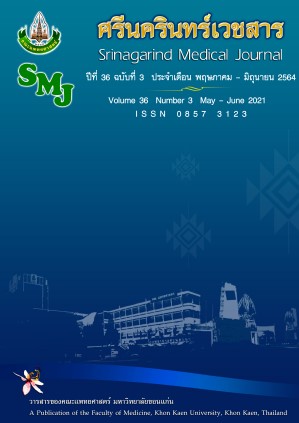Long-Term Follow-up 5 years Prognostic Value of Estimating Functional Capacity and Return to work in Work force age Patients of Post CABG or Valvular Surgery
Keywords:
CABG; Valvular Surgery; METs;Metabolic EquivalentAbstract
Background and Objectives: Improving functional activity and could return to work in labor age is the long term goal of post cardiac surgery rehabilitation.Long term follow up was discreted,therefore mail tracking is another option for 1) Comparison of Metabolic Equivalent (METs) from a 12-activity questionnaire (DASI) among patients of five years after CABG or valve surgery with pre-surgery 2) compared METs of the returning and no returned groups and 3) METs study was in return to work group.
Methods: Retrospective study in patients after CABG or valve surgery for 5 years. The samples were selected from QSHC medical record from 2012-2013, who were 15-60 years old that completed pre surgery DASI questionnaire. DASI and level of work questionnaire were sent by mail. The received METs was analyzed with SPSS program.
Results: 1) METs after 5 years of surgery were higher than before surgery (p = 0.000) 2) METs in the group that returned to work was higher than the no returned to work group (p = 0.024) 3) METs in the DASI questionnaire was higher than the METs in level of work questionnaire (p = 0.00). Returned to work 's METs from level of work questionnaire was moderate to heavy level (5.55 ± 1.72 METs).
Conclusions: Functional activity of CABG and valvular surgery patients increased from 5 years post surgery. The returned to work group was higher functional activity than those of the no returned group.The returning group had a moderate to heavy intensity level.
References
2. นิศาชล รัตนมณี, ประสบชัย พสุนนท์. อัตราการตอบกลับของแบบสอบถามในงานวิจัยเชิงปริมาณ. JHS.TRU 2019; 13: 180-188.
3. Tang WW, Topol EJ, Fan Y, Wu Y, Cho L, Stevenson C, et al. Prognostic value of estimated functional capacity incremental to cardiac biomarkers in stable cardiac patients. JAHA 2014; 20: 1-9.
4. Grodin JL, Hammadah M, Fan Y, Hazen SL, Tang WW. Prognostic value of estimating functional capacity with the use of the duke activity status index in stable patients with chronic heart failure. J Card Fail 2015; 21: 44-50.
5. Vibulchai N, Thanasilp S, Preechawong S, Broome ME. Validation of the Thai version of the Duke Activity Status Index in patients with a previous myocardial infarction. Asian Biomed 2014; 8: 623-630.
6. กิตติพล จิตต์อาจหาญ, กนกกาญจน์ กอบกิจสุมงคล, เพิ่มสุข เอื้ออารี, ศิริพร แสงมณี, นพวรรณ แสนเจริญ สุทธิกุล. ปัจจัยที่เกี่ยวข้องกับการกลับไปทำงานของผู้ป่วยหลังผ่าตัดหัวใจ. เวชศาสตร์ฟื้นฟูสาร 2011; 21: 43-49.
7. ฝ่ายพัฒนาความปลอดภัย สถาบันความปลอดภัยในการทำงาน กรมสวัสดิการและคุ้มครองแรงงาน.แนวปฏิบัติตามกฎกระทรวง การกำหนดมาตรฐานในการบริหารและการจัดการด้านความปลอดภัย อาชีวอนามัย และสภาพแวดล้อมในการทำงานเกี่ยวกับความร้อน แสงสว่าง และเสียง พ.ศ. 2549 [อินเทอร์เน็ต]. [เข้าถึงเมื่อ 20 ธ.ค. 2562]. เข้าถึงได้จากhttp://medinfo2.psu.ac.th/commed/occmed/images/TIS18001/tisp4/law%20Physi/images/law/practice_hot.pdf
8. 8.Ainsworth BE, Haskell WL, Herrmann SD, Meckes N, Bassett Jr DR, TudorLC, et al. Compendium of Physical Activities: a second update of codes and MET values. Med Sci Sports Exerc 2011; 43: 1575-1581.
9. Fonager K, Lundbye CS, Andreasen JJ, Futtrup M, Christensen AL, Ahmad K, et al. Work status and return to the workforce after coronary artery bypass grafting and/or heart valve surgery: a one-year-follow up study. Rehabil Res Pract 2014: 1-6.
10. Biering K, Hjøllund NH, Lund T. Methods in measuring return to work: a comparison of measures of return to work following treatment of coronary heart disease. J Occup Rehabil 2013; 23: 400-405.
11. Davoodi S, Sheikhvatan M, Karimi A, Ahmadi SH, Sheikhfathollahi M. Determinants of social activity and work status after coronary bypass surgery. Asian Cardiovasc and Thorac Ann 2010; 18: 551-556.
12. Sire S. Physical training and occupational rehabilitation after aortic valve replacement. Eur Heart J 1987; 8: 1215-1220.
13. Lunel C, Laurent M, Corbineau H, Boulmier D, Chaperon J, Guillo P, et al. A Return to work after cardiac valvular surgery. Retrospective study of a series of 105 patients. Arch Mal Coeur et des Vaiss 2003; 96: 15-22.
14. Shigenobu M, Senoo Y, Teramoto S. Return to work after heart valve replacement. Acta Med Okayama 1989; 43: 185-192.
15. Pere E, Saraste M, Inberg M, Arstila M, Vuori I, Kallio V. Clinical findings and return to work after heart valve replacement. Scand J Rehabi Med 1984; 16: 65-70.
16. Monpere C, Bertrand S, Kapusta P, Vernoche P, Quilliet N, Rajoelina A. Return to work of professional drivers after cardiac rehabilitation. Arch Mal Coeur Vaiss 1992; 85: 987-992.
17. Marcassa C, Giordano A, Giannuzzi P. Five-year hospitalisations and survival in patients admitted to inpatient cardiac rehabilitation after cardiac surgery. Eur J Prev Cardiol 2016; 23: 1609-1617.
18. Lemeshow S, Hosmer DW, Klar J, Lwanga SK. World Health Organization. Adequacy of sample size in health studies. Chichester: Wiley; 1990.
19. Albouaini K, Egred M, Alahmar A, Wright DJ. Cardiopulmonary exercise testing and its application. Postgrad Med J 2007; 83: 675-682.




